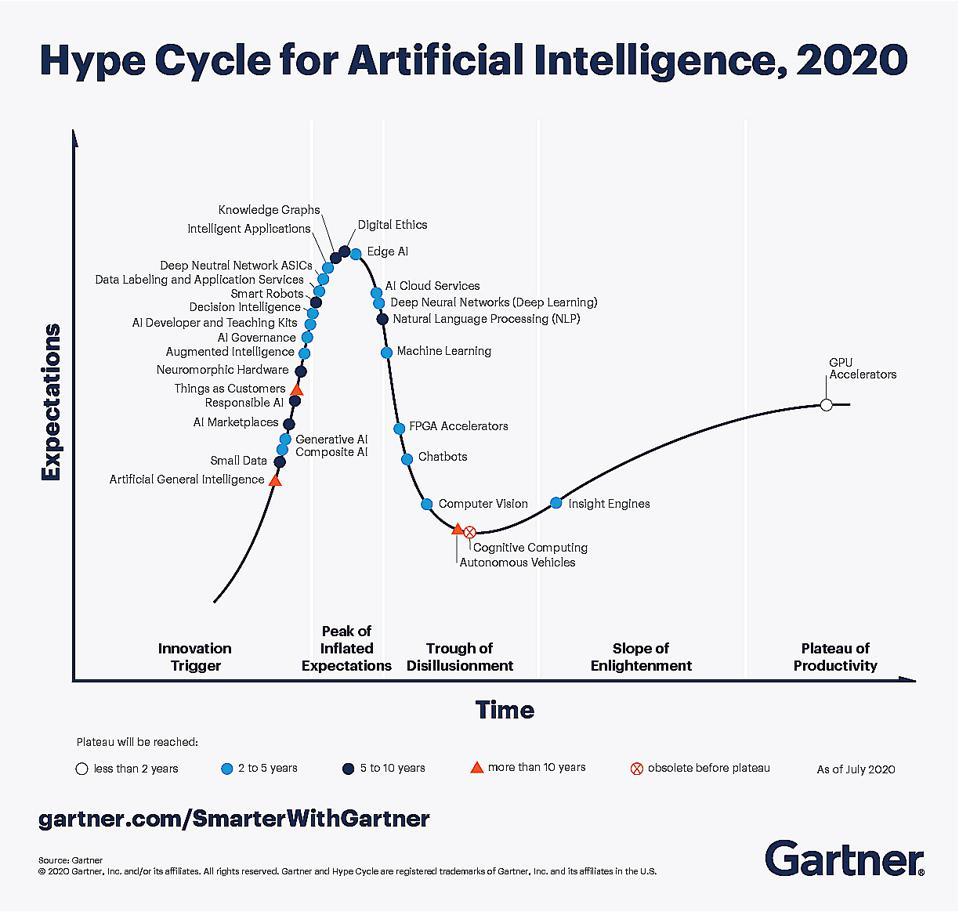The hype around Artificial Intelligence and Machine Learning still hasn’t faded away. Apart from the media’s attention, an increase in investment is also a good indicator of this ongoing trend.
According to Statista, AI investments have increased from $16.5 to one Billion during 2011-2019. BuyShares further states that up until 2020, AI startups have received 62.7 billion pounds in investment rounds, a 35% increase compared to previous years. While the coronavirus is raging in the background, this number becomes even more impressive.
Looking at these statistics, we can safely assume that the AI market is still alive and well. One thing that changes throughout the years is the directions that attract the most attention and the directions that have already found their place on the market.
Press vs. Reality
Self-driving vehicles, autonomous robots, and stories that write themselves – These are the kind of topics the media relentlessly talks about, but we rarely see any real-world examples.
On the other hand, real projects are left behind the curtains. The reason is simple – These boring applications cause no interest in the press nor its readers. All in all, we’re left with the illusion that the primary goal of AI is to replace human workers altogether. But while the news covers futuristic topics such as autonomous vehicles and General Artificial Intelligence, different AI platforms are slowly creeping into the workforce to make our jobs easier.
Gartner’s hype cycle
Gartner is the leading research and consulting firm that publishes an annual analysis of the technological industry. The model uses for these statistics is known as the hype cycle. A hype cycle is a chart with 5 points, and it shows which technologies are under a lot of attention but with no use-case and which are being adopted and implemented in the real world.
Along with general cycles, in 2020, Gartner published a report for Artificial Intelligence. Here you’ll find a lot more directions than you could’ve imagined. In this article, we’ll discuss a couple of them.

From the tools generated by Artificial Intelligence, the most successful turned out to be Chatbots. According to Gartner, chatbots will see a 100% increase in the upcoming 2-5 years. As CX Networks notes, 53% of American companies see AI tools as important in creating customer-oriented culture. One Georgian company that works in this direction is PulsarAI.
On the fifth point of Gartner’s hype cycle, the plateau of productivity, we see GPU accelerators that greatly aid the adoption of AI tools. If we trust the projections, GPU accelerators will see a 100% increase in less than two years.
As for the technical part, deep learning, machine learning, and computer vision are the mechanisms that already proved themselves and are used to create different software. These mechanisms are still evolving, and we see new models popping up, which we’’ be discussing in a minute.
All-in-all, 2020 has been a productive year for the artificial intelligence market. As Gartner notes:
“AI is starting to deliver on its potential, and its benefits for businesses are becoming a reality.”
New trends
Artificial Intelligence combines dozens of different directions. Additionally, it is still in its infancy and goes through continuous development. The fact that we have some clear use cases doesn’t mean that innovations won’t happen anymore. In the 2020 Gartner hype cycle, five new directions gain more and more attention from everybody.
AI development tools – Up until now, AI development was mainly the job of data scientists and Ph.D. students. Today, Amazon and Microsoft offer tools that allow any developer to build an AI model, as for Google, they made the process accessible for non-developers. On top of that, there are a lot more resources shared on Arxiv and Github. The reason? Democratizing AI development will lead to much more and exciting projects.
Generative AI – This is a new trending model for machine learning that allows the system or neural networks to learn independently and produce unique content, be it images, text, or even code.
The most impressive generative AI system was created by Elon Musk’s company OpenAI. GPT-3, a natural language processing system, can generate stories, poems, and code, too.
Responsible AI – This trend combines the efforts targeted at making ethical decisions around the adoption of Artificial Intelligence, as well as the rules that should be implemented in it.
The democratization of AI is as risky as it is useful. We face challenges such as racist systems and autonomous decision-making by the AI algorithms. These are the issues that require urgent attention as soon as possible. Responsive AI is targeted precisely at that.
The main goal of these new trends is to industrialize Artificial Intelligence. After the system found its place on the global market, now every new big project is trying to regulate and secure AI development. Gartner divides the new directions into two main groups: AI democratization and industrialization. This means that the regulation and standardization of Artificial Intelligence becomes a government’s job, while innovations in this space are open to any developer. While it was hard to get started on the new tech before, it is becoming easier and more accessible to do so today.
And what idea do you have?




A look at today’s AI market
03 November 2020The hype around Artificial Intelligence and Machine Learning still hasn’t faded away. Apart from the media’s attention, an increase in investment is also a good indicator of this ongoing trend.
According to Statista, AI investments have increased from $16.5 to one Billion during 2011-2019. BuyShares further states that up until 2020, AI startups have received 62.7 billion pounds in investment rounds, a 35% increase compared to previous years. While the coronavirus is raging in the background, this number becomes even more impressive.
Looking at these statistics, we can safely assume that the AI market is still alive and well. One thing that changes throughout the years is the directions that attract the most attention and the directions that have already found their place on the market.
Press vs. Reality
Self-driving vehicles, autonomous robots, and stories that write themselves – These are the kind of topics the media relentlessly talks about, but we rarely see any real-world examples.
On the other hand, real projects are left behind the curtains. The reason is simple – These boring applications cause no interest in the press nor its readers. All in all, we’re left with the illusion that the primary goal of AI is to replace human workers altogether. But while the news covers futuristic topics such as autonomous vehicles and General Artificial Intelligence, different AI platforms are slowly creeping into the workforce to make our jobs easier.
Gartner’s hype cycle
Gartner is the leading research and consulting firm that publishes an annual analysis of the technological industry. The model uses for these statistics is known as the hype cycle. A hype cycle is a chart with 5 points, and it shows which technologies are under a lot of attention but with no use-case and which are being adopted and implemented in the real world.
Along with general cycles, in 2020, Gartner published a report for Artificial Intelligence. Here you’ll find a lot more directions than you could’ve imagined. In this article, we’ll discuss a couple of them.
From the tools generated by Artificial Intelligence, the most successful turned out to be Chatbots. According to Gartner, chatbots will see a 100% increase in the upcoming 2-5 years. As CX Networks notes, 53% of American companies see AI tools as important in creating customer-oriented culture. One Georgian company that works in this direction is PulsarAI.
On the fifth point of Gartner’s hype cycle, the plateau of productivity, we see GPU accelerators that greatly aid the adoption of AI tools. If we trust the projections, GPU accelerators will see a 100% increase in less than two years.
As for the technical part, deep learning, machine learning, and computer vision are the mechanisms that already proved themselves and are used to create different software. These mechanisms are still evolving, and we see new models popping up, which we’’ be discussing in a minute.
All-in-all, 2020 has been a productive year for the artificial intelligence market. As Gartner notes:
“AI is starting to deliver on its potential, and its benefits for businesses are becoming a reality.”
New trends
Artificial Intelligence combines dozens of different directions. Additionally, it is still in its infancy and goes through continuous development. The fact that we have some clear use cases doesn’t mean that innovations won’t happen anymore. In the 2020 Gartner hype cycle, five new directions gain more and more attention from everybody.
AI development tools – Up until now, AI development was mainly the job of data scientists and Ph.D. students. Today, Amazon and Microsoft offer tools that allow any developer to build an AI model, as for Google, they made the process accessible for non-developers. On top of that, there are a lot more resources shared on Arxiv and Github. The reason? Democratizing AI development will lead to much more and exciting projects.
Generative AI – This is a new trending model for machine learning that allows the system or neural networks to learn independently and produce unique content, be it images, text, or even code.
The most impressive generative AI system was created by Elon Musk’s company OpenAI. GPT-3, a natural language processing system, can generate stories, poems, and code, too.
Responsible AI – This trend combines the efforts targeted at making ethical decisions around the adoption of Artificial Intelligence, as well as the rules that should be implemented in it.
The democratization of AI is as risky as it is useful. We face challenges such as racist systems and autonomous decision-making by the AI algorithms. These are the issues that require urgent attention as soon as possible. Responsive AI is targeted precisely at that.
The main goal of these new trends is to industrialize Artificial Intelligence. After the system found its place on the global market, now every new big project is trying to regulate and secure AI development. Gartner divides the new directions into two main groups: AI democratization and industrialization. This means that the regulation and standardization of Artificial Intelligence becomes a government’s job, while innovations in this space are open to any developer. While it was hard to get started on the new tech before, it is becoming easier and more accessible to do so today.
And what idea do you have?